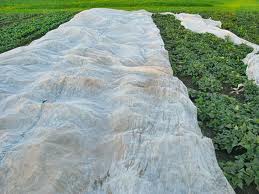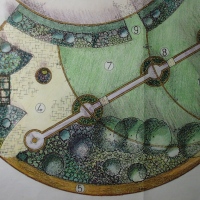 In this third article about climate change and the garden (originally published in 2013), I set out some ideas on how the gardener can manage the day-to-day garden environment and other short-term measures to modify the impact of abnormal weather events. As previous articles have outlined, these seem likely to become more frequent as a result of the warming of the planet and associated climate changes around the world.
In this third article about climate change and the garden (originally published in 2013), I set out some ideas on how the gardener can manage the day-to-day garden environment and other short-term measures to modify the impact of abnormal weather events. As previous articles have outlined, these seem likely to become more frequent as a result of the warming of the planet and associated climate changes around the world.
I think it’s fair to say that effective gardening in the future will rely on gardeners:
Being well prepared for abnormal weather events and taking steps to change the design, planting and systems in the garden to cope (the subject of my previous article)
Being aware of, and using, a range of information about the weather, plants, pests etc. (I’ll look at these issues in my final article), and
Developing gardening skills and techniques as well as a flexible, ‘can do’ attitude – or what I’m calling the ‘Constant Gardener’ – the subject of this article.
‘Constant’ implies dependability, ongoing attention and responsiveness, qualities that the ‘climate change gardener’ will need if the gardens of tomorrow are to be as productive, beautiful and healthy as today. Just like Justin Quayle’s ‘gentle but diligent attention to his plants’ in the film of the same name, in fact!
The focus of the Constant Gardener is on how those annual and biennial plants that we raise from seed can be nurtured and protected from the worst excesses of the weather. However, attention to how perennials, shrubs and trees are faring will also require vigilance throughout the year and possibly remedial action, if the weather threatens to harm a particular plant or area of the garden.
So, what can the Constant Gardener do?
-
To cope with periods of hot sun, consider temporary shades that can be moved around the garden to provide protection for tender plants where there is no natural shade – e.g awnings slung between posts which can be moved to shade beds or borders at risk from ‘frying’. I mentioned the value of permanent structures like pergolas and arbours in my last article.
-
To ensure successful nurturing of plants from seed, sow in smaller quantities and in successive batches – especially if you’re growing food, where successional sowings will in any case give you (hopefully) a steady supply rather than a glut followed by nothing.
-
Carry out plant propagation and nurturing under cover and in frost free spaces – ideally you will have in place a variety of growing conditions, light frost-free rooms in the house, greenhouse/conservatory and cold frame – make sure you use them effectively to harden plants off before they are fending for themselves outside.
-
Choose plants – especially fruit and veg – from varieties that you like to eat and which are resilient or suited to the sorts of conditions you’ve created in your garden and the weather extremes that seem likely (though this itself may be increasingly difficult to predict). For a ‘belt and braces’ approach, grow a few different varieties if you’re not sure about the best ones for you and your garden. Your choice may also mean that you’ll need to compromise a bit on quality as a trade – off for resilience.
-
If you’re buying plants, be vigilant about pests and diseases – with increased plant mobility between countries as well as an increased geographical growing range for some species, the risk of importing pests and diseases is increasing.
-
Delay sowing if your soil is slow to warm up – early sowing is a gamble where the odds are against you, whereas sow a little late and the odds will probably shift in your favour.
-
Be prepared to accept failure and learn from it for next time. Keeping records of seasonal weather, the varieties grown and how they fared is invaluable when growing food crops.
-
If there’s a choice, opt for growing quick food crops – this way there’s less time for them to be affected by abnormal weather.
-
Remember the ‘transfer window’ – make sure you prick out, pot up and pot on regularly, before plants give up the ghost or succumb to ‘damping off’. Aim to grow a few strong plants rather than lots of weaklings! This will make for better resistance to pests and diseases.
-
Rotation plus – you’re probably aware of the importance of moving your food crops around the garden to avoid the build up of pests and diseases associated with one family of fruit or veg, as well as moderating the drain the plants put on the soil’s fertility. The Constant Gardener should also consider successional sowings of the same crop in different parts of the garden if possible (what you might call ‘Divided Bed’ gardening) and if you want to be ultra cautious you could use different varieties too!
-
Protect young plants against frost – use fleece, cloches or other temporary covers
-
If plants have suffered from a wet/flooded winter, give them a spring feed, mulch over the root area and give them a foliar feed during the growing season to build up their strength.
-
Use water harvested from wet periods (in butts, barrels or tanks) to water effectively in dry times. Use pipes and ‘SIP’ plastic bottle feeders plunged into the ground to ensure water gets straight to the plant’s roots. Avoid using sprinklers and hoses as much of the water they deposit on the surface of grass or earth evaporates. You could go for a green solar -powered watering system like the one in the picture!
-
Over – winter tender plants in containers in an inside, well-lit and frost-free room or greenhouse, conservatory, or cold frame (ideally with insulation and the scope for added heat when necessary). If they can’t be moved out of the ground, mulch with suitable organic material to protect the roots, and for some wrap up the stem and branches with fleece or similar material.
-
Keep glasshouse, conservatory and cold frame panes clean to maximise sunlight.
-
Look after wildlife and they’ll look after your garden. Feed birds in tough winter spells and create habitats through planting etc. to attract beneficial insects and other ‘critters’ that will keep pests at bay.
-
Avoid using power tools and equipment if at all possible as these will contribute to the emission of CO2 either directly or indirectly and so fuel global warming.
So, to sum up
-
Constant awareness of what the weather is bringing you and your garden
-
Constant willingness to act in the short-term as well as being prepared
-
Constant action to propagate, nurture and protect your plants!
If you have any comments on these ideas or have some of your own, I’d love to hear from you! My final article will look at plant awards, hardiness ratings, pest and disease information and the future of longer term weather forecasting as ways of keeping the gardener well informed.
 Previous articles in this series:
Previous articles in this series:
Four Seasons in One Day (2): Preparing the garden for climate change
Four Seasons in One Day (1): Climate change and the garden
Source:
‘Monty’s Garden’– article by Monty Don, Gardeners’ World Magazine, January 2013
Further information:
Dig for Victory- how your garden can help beat climate change
Watering advice
Wikipedia- Tiwanaku
Sir John Beddington’s warnings on climate change
Britain like Madeira?
My Climate Change Garden
UK Meteorological Office – impacts of climate change on horticulture
Royal Horticultural Society – gardening in a changing climate
‘Gardening in the Global Greenhouse ‘ – summary
RSPB- guide to sustainable drainage systems (download)
RHS guide to front gardens and parking
Old School Gardener
If you’ve enjoyed reading this post and others on this blog, why not comment and join others by signing up for automatic updates via email (see side bar, above right ) or through an RSS feed (see top of page)?















 Watering-
Watering-  Further information:
Further information:




